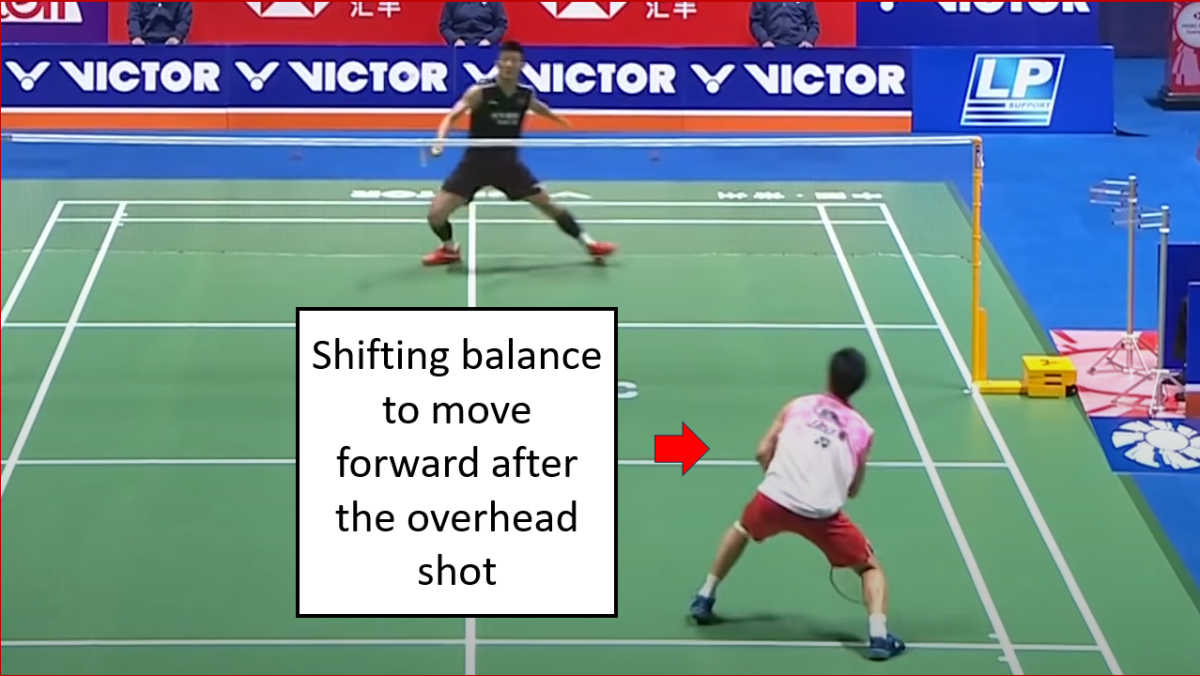I was discussing with Fred on how to improve his footwork, and one topic which keep coming up was to use less small steps. This can only be achieved when he is able to lean in the direction he wants to go. That means in the most simplistic way, he must be able to shift his balance quickly. Let’s discuss.
One of the players with the smoothest footwork in recent times is Kento Momota. Before the injuries caused by the car accident, he was simply peerless. Nobody came close to him in terms of his speed and grace on court. His speed on court came not from the pure acceleration of his legs. He was not fast because his feet and steps were much faster. He was fast because he could change directions quickly and then take large steps to move quickly.
Ginting Versus Momota
Anthony Ginting is fast on court, simply because his feet are fast. He is able to take many many small steps quickly. This allows him to change directions quickly. When another player takes 1 step, Ginting could take 3 or 4 small steps. And in using his fast twitch muscles this way, he is supremely fast on court. This is a different type of fast compared with Momota.
Momota too has rapid small steps, but he does not use it that often to move. He uses it sparingly, only when he needs to redirect himself because the opponent has done some form of deception on him, or when he needs to recover quickly from a dive. Otherwise, Momota goes in with his big steps. And he is immensely smooth with his footwork.
In the rally above, it shows Momota going on the attack against Ginting. What I want to show here is the rapid steps used by Ginting in order to move quickly. Ginting is quick because he is fast on his feet, and he uses lots of rapid small steps to be fast.
It is not shown in this rally, but Ginting also does not turn his body as he hits overhead shots. He does not shift his balance as he hits overhead shots. And he uses additional small steps to rebalance himself after an overhead hit.
Momota Versus Chen Long
Even Chen Long, who does not use that many small steps, uses relatively smaller steps compared with Momota. And with that, Chen Long uses more small steps than Momota.

The 30 shots rally above showns above shows Momota moving smoothly around the court. When Momota runs the full diagonal after an overhead shot, he takes 3 big steps. Chen Long also takes 3 big steps when he runs the full diagonal, but he takes an extra small step to rebalance himself after his overhead shot before he starts to run.
Chen Long always takes an extra small step before he moves after a shot to rebalance himself. He does not shift his balance like what Momota does. He uses the small step to rebalance and then power himself in the direction he wants to go. I am not talking about the split step as the split step is done right before the opponent hits the shot. Chen Long takes small step when he sees where the shuttle is going, he needs to take the step to rebalance and launch himself in the new direction.
If we look closely at Chen Long’s stance, he takes a position which is very upright. More so than Momota. Chen Long tends to hit his shots without a body turn. That means he does not shift his balance after the hit, and this explains why he uses an extra small step to rebalance himself after the hit. Chen Long needs to use that small step to power his movement to the next shot. This is a very tiring and inefficient way of moving around on court. Chen Long compensates for this by being extremely fit.
Conclusion
Momota has the smoothest footwork around due to his mastery of the shift in balance. By shifting his balance around, he is able to save on his footwork. He is able to move by taking less steps than his opponents. This makes him more efficient with his footwork, and it opens up the option for him to outlast his opponents in a match.
Shifting of balance not only saves on the number of steps required to move in a certain direction, it also increases the distance covered. This means, the player who shifts his balance gains more reach. Momota is able to reach further with his dives. When he reverses back, he has better coverage. He is able to reverse further and faster too.
Mastery of balance this way is the ultimate form of footwork. It makes a player move not only with his feet, but his entire body. This is the ultimate form of efficiency. The player who is able to shift his balance this way is able to move in the most efficient way possible by utilizing the body mechanics of the human body. Therefore, it is a skill which all of us who play badminton strive to learn.
I discussed the topic of balance on the advanced topic page here:
Below is a video where I teach the basics of shift the balance as we turn to the back to Fred.
That’s it for this entry.
Until the next entry, eat well, get plenty of rest and keep the badminton going!
Berita Olahraga
News
Berita Terkini
Berita Terbaru
Berita Teknologi
Seputar Teknologi
Drama Korea
Resep Masakan
Pendidikan
Berita Terbaru
Berita Terbaru
Download Film
Gaming center adalah sebuah tempat atau fasilitas yang menyediakan berbagai perangkat dan layanan untuk bermain video game, baik di PC, konsol, maupun mesin arcade. Gaming center ini bisa dikunjungi oleh siapa saja yang ingin bermain game secara individu atau bersama teman-teman. Beberapa gaming center juga sering digunakan sebagai lokasi turnamen game atau esports.
